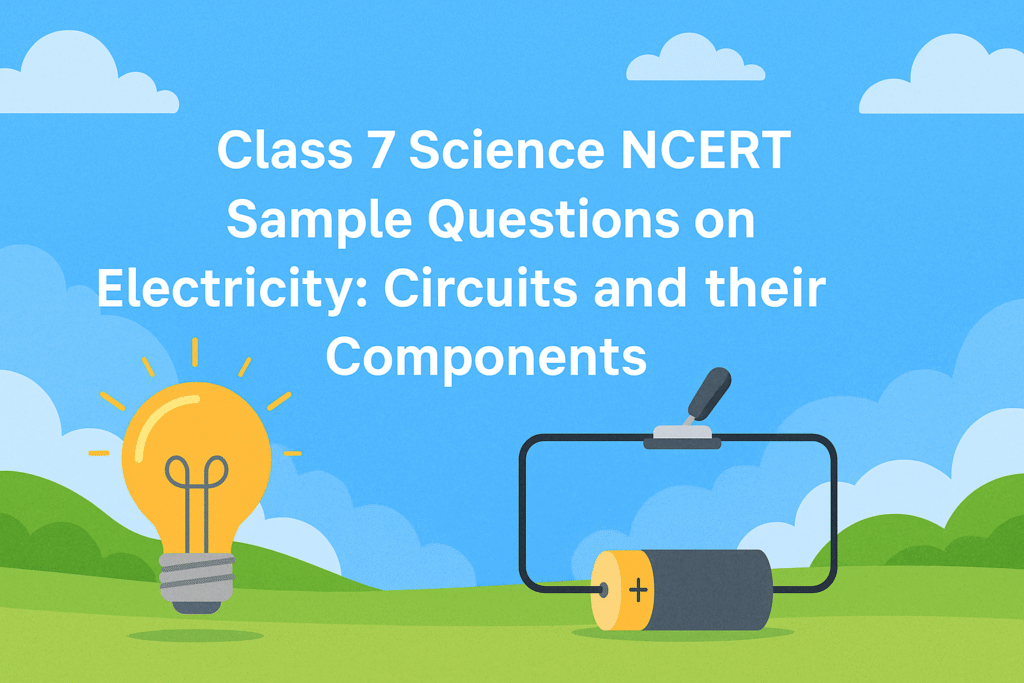Welcome to Bodhiclasses — your trusted source for clear, curriculum-aligned science content for CBSE students. In this post, we present a sample question paper based on Class 7 Science Chapter 3: Electricity – Circuits and their Components. This worksheet includes MCQs, short answer, and higher-order thinking questions for revision, practice, and concept clarity.

Sample Question Paper Class 7 Science – Chapter 3: Electricity – Circuits and their Components

Section A – Multiple Choice Questions (1 mark each)
- What is the source of electricity in a torch?
A) Wire
B) Bulb
C) Switch
D) Cell - Which of the following materials is a conductor of electricity?
A) Eraser
B) Plastic scale
C) Aluminium foil
D) Paper - In a closed circuit, current flows from:
A) Negative to positive terminal
B) Cell to bulb only
C) Positive to negative terminal
D) Switch to wire - Which of the following is an insulator?
A) Coin
B) Metal key
C) Candle wax
D) Iron nail - A filament is found in:
A) Cell
B) Switch
C) Incandescent lamp
D) Wire - A switch is used to:
A) Generate electricity
B) Increase current
C) Complete or break the circuit
D) Store charge - LED glows only when:
A) Connected in any direction
B) Connected with both terminals to the same wire
C) Current flows in one specific direction
D) More than three cells are used - Which statement is incorrect?
A) A switch is the source of current
B) Switch helps control electricity use
C) OFF switch creates an air gap
D) Switch completes or breaks the circuit - In an LED, the longer wire represents:
A) Negative terminal
B) Positive terminal
C) Neutral wire
D) Fuse wire - A circuit with a broken lamp filament will:
A) Glow brightly
B) Get overheated
C) Not glow
D) Make sound
Chapter 3: Electricity – Circuits and their Components
Section B – Very Short Answer Questions (1 mark each)
- Name the part of the lamp that glows.
- What do we call the diagram made using symbols for electric components?
- What kind of current flows from a battery?
- Name any one device that uses an LED.
- What is the function of a switch?
- Define a conductor with an example.
- What does a cell symbol’s long line represent?
- Name one insulator used to cover wires.
- What happens if you don’t strip the insulation from wires in a circuit?
- Can a cell be connected in reverse in a torch? What happens?
Section C – Short Answer Questions (2 marks each)
- Why does the lamp not glow if an insulator is used in the circuit?
- State two differences between an LED and an incandescent lamp.
- What safety precautions should be taken while handling electric devices?
- How can we test if a cell is working using a lamp and wires?
- What is the role of a filament in an electric lamp?
Section D – Higher Order Thinking Skills (HOTS)/Applied Questions (2–3 marks each)
- You made a circuit using a working lamp, battery, and wires, but it does not glow. List three possible reasons.
- Design an activity to identify working and non-working electric cells using a simple circuit.
- Why does the LED glow in one connection and not in the reverse? Explain with current flow direction.
- How can you identify the positive and negative terminals of a battery with faded markings using an LED?
- In a torch using two cells and an LED, what will happen if one cell is reversed? Explain the reason.
Chapter 3: Electricity – Circuits and their Components
📝 Answer Sheet
Section A – MCQs
- D
- C
- C
- C
- C
- C
- C
- A
- B
- C
Section B – Very Short Answers
- Filament
- Circuit diagram
- Direct Current (DC)
- Torch / Mobile Phone / Indicator Light
- To open or close an electric circuit
- A conductor allows electric current to flow through it. Example: Copper
- Positive terminal
- Plastic or rubber
- Circuit remains incomplete; lamp won’t glow
- The lamp may not glow if cells are reversed
Section C – Short Answers
- Insulators do not allow current to flow, breaking the circuit.
- LED: no filament, works on polarity; Incandescent: has filament, works either way.
- Avoid wet hands, don’t touch live wires, use insulated tools, avoid damaged plugs.
- Connect cell with lamp and wires; if lamp glows, cell is working.
- The filament heats up and glows, producing light.
Section D – HOTS
- Reasons: lamp fused, wire connections loose, cell discharged
- Connect each cell to a lamp; observe which cell makes lamp glow
- LED conducts in one direction only; reverse connection breaks current flow
- Connect LED; terminal connected to longer leg is positive
- LED won’t glow; reversed cell breaks the current flow direction required by LED


